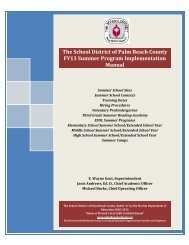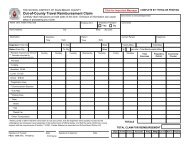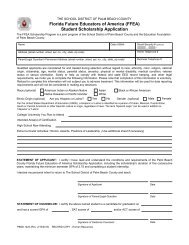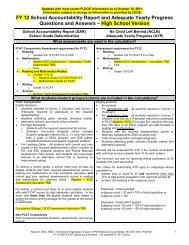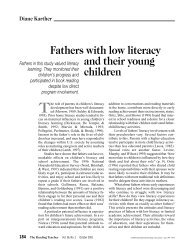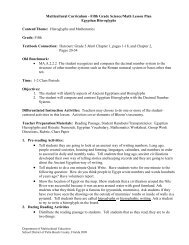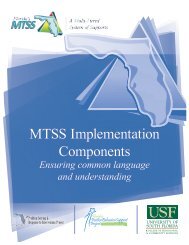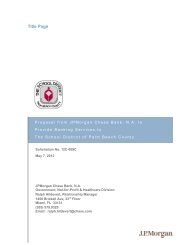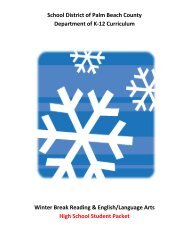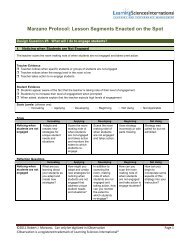Assessment (ESOL Testing and Evaluation) - The School District of ...
Assessment (ESOL Testing and Evaluation) - The School District of ...
Assessment (ESOL Testing and Evaluation) - The School District of ...
You also want an ePaper? Increase the reach of your titles
YUMPU automatically turns print PDFs into web optimized ePapers that Google loves.
PROFESSIONAL LEARNING INSERVICE COMPONENT INFORMATION<br />
4. Demonstrate underst<strong>and</strong>ing <strong>of</strong> the advantages <strong>and</strong> limitations <strong>of</strong> assessments,<br />
including the array <strong>of</strong> accommodations allowed for ELLs <strong>of</strong> diverse backgrounds<br />
<strong>and</strong> at varying English pr<strong>of</strong>iciency levels.<br />
5. Distinguish among ELLs’ language differences, giftedness, <strong>and</strong> special education<br />
needs.<br />
St<strong>and</strong>ard 2: Language Pr<strong>of</strong>iciency <strong>Assessment</strong><br />
Teachers will appropriately use <strong>and</strong> interpret a variety <strong>of</strong> language pr<strong>of</strong>iciency<br />
assessment instruments to meet district, state, <strong>and</strong> federal guidelines, <strong>and</strong> to inform their<br />
instruction. Teachers will underst<strong>and</strong> their uses for identification, placement, <strong>and</strong><br />
demonstration <strong>of</strong> language growth <strong>of</strong> ELLs from diverse backgrounds <strong>and</strong> at varying<br />
English pr<strong>of</strong>iciency levels. Teachers will articulate the appropriateness <strong>of</strong> ELL<br />
assessments to stakeholders. (20 points)<br />
Performance Indicators for St<strong>and</strong>ard 2:<br />
1. Underst<strong>and</strong> <strong>and</strong> implement district, state, <strong>and</strong> federal requirements for<br />
identification, reclassification, <strong>and</strong> exit <strong>of</strong> ELLs from language support programs,<br />
including requirements <strong>of</strong> the LULAC Consent Decree.<br />
2. Identify <strong>and</strong> use a variety <strong>of</strong> assessment procedures for ELLs <strong>of</strong> diverse<br />
backgrounds <strong>and</strong> varying English pr<strong>of</strong>iciency levels.<br />
3. Use multiple sources <strong>of</strong> information to assess ELLs’ language <strong>and</strong> literacy skills<br />
<strong>and</strong> communicative competence.<br />
St<strong>and</strong>ard 3: Classroom-Based <strong>Assessment</strong> for ELLs<br />
Teachers will identify, develop, <strong>and</strong> use a variety <strong>of</strong> st<strong>and</strong>ards- <strong>and</strong> performance-based,<br />
formative <strong>and</strong> summative assessment tools <strong>and</strong> techniques to inform instruction <strong>and</strong><br />
assess student learning. Teachers will underst<strong>and</strong> their uses for identification, placement,<br />
<strong>and</strong> demonstration <strong>of</strong> language growth <strong>of</strong> ELLs from diverse backgrounds <strong>and</strong> at varying<br />
English pr<strong>of</strong>iciency levels. Teachers will articulate the appropriateness <strong>of</strong> ELL<br />
assessments to stakeholders. (20 points)<br />
Performance Indicators for St<strong>and</strong>ard 3:<br />
1. Use performance-based assessment tools <strong>and</strong> tasks that measure ELLs’ progress<br />
in English language <strong>and</strong> literacy development.<br />
2. Underst<strong>and</strong> <strong>and</strong> use criterion-referenced assessments appropriately with ELLs<br />
from diverse backgrounds <strong>and</strong> at varying English pr<strong>of</strong>iciency levels.<br />
3. Use various tools <strong>and</strong> techniques to assess content-area learning (e.g., math,<br />
science, social studies) for ELLs at varying levels <strong>of</strong> English language <strong>and</strong><br />
literacy development.<br />
4. Prepare ELLs to use self- <strong>and</strong> peer-assessment techniques, when appropriate.<br />
5. Assist ELLs in developing necessary test-taking skills.<br />
4. Assess ELLs’ language <strong>and</strong> literacy development in classroom settings using a<br />
variety <strong>of</strong> authentic assessments, e.g., portfolios, checklists, <strong>and</strong> rubrics.<br />
2010 – Multicultural Education



